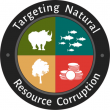
Gabriel Sipos
Anti-Corruption Coordinator
Fighting natural resource corruption is essential for successful conservation: Very Bad People by Patrick Alley
(A Book Commentary)
Patrick Alley’s recounting of Global Witness’s story over the last few decades shows how surprisingly closely the aims and approaches of conservation and anti-corruption organisations align. To make better progress on both fronts, more intensive cooperation between the two disciplines is long overdue. TRAFFIC’s decision to create a post for an Anti-corruption Coordinator was a clear step in that direction. Prior to joining TRAFFIC in this role, I worked for Transparency International, the largest anti-corruption movement in the world, for over a decade.
Right from the outset in 1993, Global Witness (GW), despite not being an environmentally focused organisation, uncovered links between corruption, illegal wildlife trade and warfare. It was set up to explore how to halt the long-running civil war in Cambodia which, at the time, was over on paper yet not in reality. After the hair-raising ground research in the region, they provided the world with evidence that corruption within both the Thai and Cambodian governments was allowing illegal timber exports to fund the conflict. By lobbying the US government, the big power broker in the region, GW managed to increase the pressure to halt the illegal trade and essentially, the conflict itself.
Natural resource riches and corruption: a deadly combination
Ever since, tackling human rights abuse, bribery and natural resource exploitation has become a hallmark of GW’s work, as recounted in the recent book by Patrick Alley, one of its founders. GW has exposed huge corrupt oil deals in Nigeria and Equatorial Guinea; illegal diamond and timber exports in Liberia and Angola; and shady mining contracts in Guinea, among others. While not working directly on illegal wildlife trade as we do at TRAFFIC, the nefarious ingredients of corruption, organised crime and abuse of power are often present in our area of work, too, as the UNODC, WJC, Interpol, and many other experts have emphasised in the past years.
While GW’s core anti-corruption work rests in the investigation, as opposed to TRAFFIC’s emphasis on cooperation and capacity-building solutions, the strategies used by GW sound very familiar to us: analysing data and evidence first and foremost, employing a ‘follow-the-money’ approach, engaging local partners, and lobbying key governments and multilateral bodies such as the UN.
For instance, the book recounts how when investigating illegal exports of diamonds, which were fuelling civil war in Angola in the 1990s, GW focused on key industry players such as De Beers, the largest buyer of rough diamonds in the world. The inconsistencies found in their public records and official statements enabled GW to pin down industry profits all the way to the Angolan conflict, most likely at the cost of thousands of lives. Aided by reports and advocacy by other NGOs, the UN eventually passed a resolution on “blood diamonds” while the US government and others introduced mandatory traceability schemes, severely limiting the path of such diamonds into world markets.
Echoing the evidence-based approach, we at TRAFFIC have in the past looked at trade data discrepancies to sound the alarm about illegal trade risks. Recently, we analysed Peruvian forestry permits given to companies linked to public officials to identify the risks of corruption. As all these examples indicate, having more publicly accessible data raises the chances that abuse of power will be detected and sanctioned.
Bringing more transparency to natural resources extraction and trade
So-called “crime enablers” have been a big target of GW’s work. The corrupt love to park their illegal proceeds in luxury items such as yachts, houses, or financial investments in the West. To do so successfully they rely on a number of helpers – lawyers, real estate agents, bankers, PR agents and luxury goods sellers. Many representatives of these professions have failed both the laws and their own ethical standards when GW tested them undercover. “They don’t send lawyers to jail, because we run the country,” said a New York lawyer to the supposedly corrupt African public official, while offering suggestions on how he could illegally invest money through anonymous companies.
Scandalous reports like these led to a number of recent laws requiring companies’ beneficial owners or real estate buyers to be recorded in public registers. But GW’s thirty years of work generally underline the importance of transparency in natural resource supply chains for both anti-corruption and conservation campaigners. TRAFFIC, too, has been prioritising transparency efforts, such as the development of systems that can prove the sustainability and legality of commodities such as timber and sharks by tracking every point in their supply chains.
Indeed, public access to logging, licensing, or exploration contracts raises the accountability of those who sign such deals, limiting corruption as well as natural resource overuse. Similarly, access to reliable data on deforestation and natural resource trade enables tracking compliance with national and international rules, as well as raising the possibility that illegal, corruption-facilitated actors will be uncovered. In this vein, GW has been able to tie meat importers’ supply chains to the deforestation of the Amazon by laboriously linking various trade and sales data. TRAFFIC itself has recently experimented with a big data approach in identifying potential instances of cronyism in the forestry sector.
Moreover, GW’s transparency efforts led to the creation of the Extractive Industries Transparency Initiative, an independent platform for voluntary accountability standards for governments on mineral exploitation. Perhaps such a platform can be created to develop and monitor similar standards for wildlife trade, too.
Fighting corruption is necessary, but will not solve it all
At times, I feel there is a danger of overselling corruption, and the picture portrayed by Alley is incomplete. For instance, whilst major oil and mining companies are blamed for robbing (mostly Global South) economies, the uncomfortable reality is that consumers, at least in the medium-term, have hugely profited from such deals. Living standards have risen and global poverty radically declined – all hand-in-hand with natural resource exploitation. In the long term, such a model is clearly unsustainable, and fairer pricing of natural resources is very much needed. Tackling corruption alone won’t result in an ethical global economy for all; in other words, tackling corruption is necessary yet not sufficient for saving the planet - the key problem to overcome are political and market failures within the economic model that we’ve relied on for so long.
On the other hand, I wish the book had stipulated how much of GW’s success relied on democratic institutions and liberties. Corruption, along with environmental crimes, is much more often investigated and prosecuted in the US, the UK, or other European countries. While far from perfect, governments and companies there are typically more open to public scrutiny than those residing in resource- and wildlife-rich places. NGOs and media have been given a legally protected space to seek accountability from public and private actors. Should these liberties decline – and democracies have had a tumultuous period recently – protecting the planet as well as tackling corruption will probably become much harder.
Overall, this fast-paced book offers a welcome perspective on how corruption facilitates nature crimes of all sorts. It is encouraging to see that more and more organisations, TRAFFIC included, are incorporating the anti-corruption angle into their projects in order to halt the destruction of the planet’s diversity of life. But we can do more: we should strive to reach out to anti-corruption NGOs in biodiversity-rich countries and raise their interest in conservation-related corruption. As the Global Witness story richly documents, the issues of corruption and environmental destruction are, and will continue to be, interconnected.
Very Bad People: The Inside Story of the Fight Against the World’s Network of Corruption, Patrick Alley, Monoray, 2022.
About Targeting Natural Resource Corruption (TNRC)

The Targeting Natural Resource Corruption (TNRC) project is working to improve biodiversity outcomes by helping practitioners to address the threats posed by corruption to wildlife, fisheries and forests. TNRC harnesses existing knowledge, generates new evidence, and supports innovative policy and practice for more effective anti-corruption programming. Learn more at tnrcproject.org.


